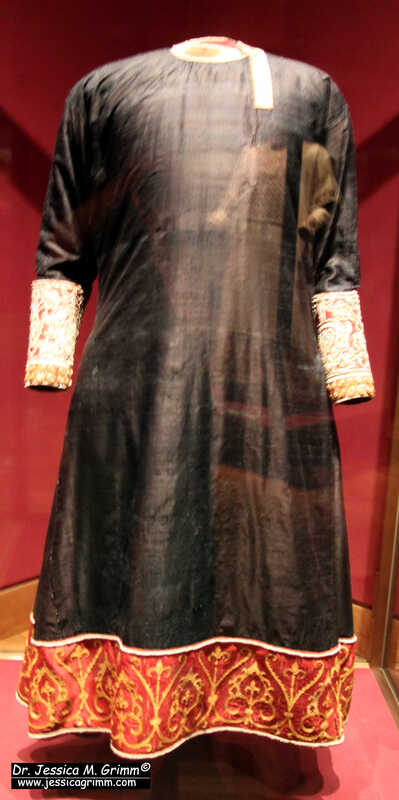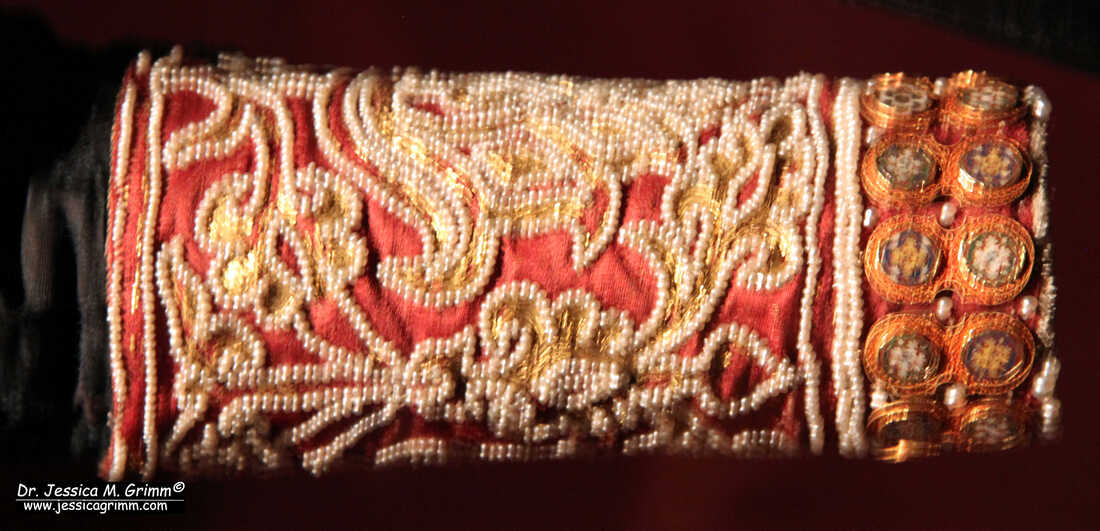|
Although my library of books on medieval (goldwork) embroidery is filling more and more IVAR shelves, I still don't have everything :). Hunting publications down is a slow process. There's no central institution or website shouting new releases from the rooftop. Finding older publications often happens by reading through the footnotes and literature lists of publications already on my shelves. Especially chapters in books in which the subject is compared to other existing examples are really helpful. In the book on the Emperor's last clothes I showed you last week, I found some new-to-me information on the embroidery on the Imperial Regalia in Vienna, Austria. I've seen those. They are in a room very close to the spectacular or nué embroideries of the Order of the Golden Fleece. As the embroidered regalia are very old, they are not exactly in the limelight. The room is very dark. So the intriguing goldwork embroidery eludes probably most visitors. Let me introduce you to a very rare goldwork embroidery technique, I had never seen before. From the above picture I took, you can already tell that seeing details of the embroidery on the blue tunic is difficult due to the reduced lighting levels. The tunic was made in the first half of the 12th century in the Royal workshops of Palermo, Sicily. The red bottom seam contains embroidery in underside couching. This is seen in more pieces made in Palermo. The really intriguing embroidery is on the cuffs. From this poor picture I took, you can probably not instantly see what is so special about the goldwork embroidery technique used. If you look real closely, you might see that the embroidery is made of a kind of gold foil tubes sewn down like elongated beads and then flattened. The museum's website states that this is probably the only surviving piece in this technique. The caption in the museum does mention 'gold tubes' in the material list. But when you are not told where to look for them, it isn't easy to spot them in the dimly lit room.
I am most intriguied by this embroidery technique as I feel that these golden tubes were quite fragile and easily deformed. Why did the embroiderer choose this technique and not (underside) couching also in use at the same time in the Imperial workshops? Is the effect achieved so different? Is it quicker to stitch? Or is it easier to make gold tubes compared to gold thread? Any ideas?
6 Comments
Rhoda Nevins
6/2/2023 14:12:25
Well this technique with the gold tubes, I find fascinating and I should imagine the embroidery would be much quicker to do. As for making the gold tubes, again I am sure would be cheaper, or I could be wrong !!
Reply
6/2/2023 14:44:02
Thank you for your ideas, Rhoda! If only somebody would sponsor us with a bunch of gold tubes to do some experiments :). I was wondering how they would make and transport those little tubes? Once made, gold thread is quite stable and handles well. But what about these tiny fragile tubes?
Reply
From a manufacturing perspective, I'm sure gold tube was much less labor intensive to produce that other types of gold threads for embroidery. Today it would be some form of extrusion. A quick Google search tells me that the first patent for extrusion was issued to Bramah in 1797, but that was for piping. Without spending the rest of the day reading about metallurgy, I do know that casting and molding were well-established techniques by the 12 century and I'm sure jewelers were rather skilled at making small tubes from gold and silver.
Reply
6/2/2023 14:47:41
Good point, Gary! As at a first glance, the embroidery looks a lot like 'normal' gold embroidery, I am suspecting that the material was quite similar too. I think that the tubes were probably made by rolling up the gold foil which was otherwise spun around a fibre core to make real gold thread. But I might be wrong.
Reply
10/2/2023 09:54:44
It is a unique piece. None of the other Palermo pieces use this technique. Maybe it was just an experiment? Probably not very successful or we would have more pieces showing the same technique, I think.
Reply
Your comment will be posted after it is approved.
Leave a Reply. |
Want to keep up with my embroidery adventures? Sign up for my weekly Newsletter to get notified of new blogs, courses and workshops!
Liked my blog? Please consider making a donation or becoming a Patron so that I can keep up the good work and my blog ad-free!
Categories
All
Archives
July 2024
|
Contact: info(at)jessicagrimm.com
Copyright Dr Jessica M. Grimm - Mandlweg 3, 82488 Ettal, Deutschland - +49(0)8822 2782219 (Monday, Tuesday, Friday & Saturday 9.00-17.00 CET)
Impressum - Legal Notice - Datenschutzerklärung - Privacy Policy - Webshop ABG - Widerrufsrecht - Disclaimer
Copyright Dr Jessica M. Grimm - Mandlweg 3, 82488 Ettal, Deutschland - +49(0)8822 2782219 (Monday, Tuesday, Friday & Saturday 9.00-17.00 CET)
Impressum - Legal Notice - Datenschutzerklärung - Privacy Policy - Webshop ABG - Widerrufsrecht - Disclaimer








 RSS Feed
RSS Feed